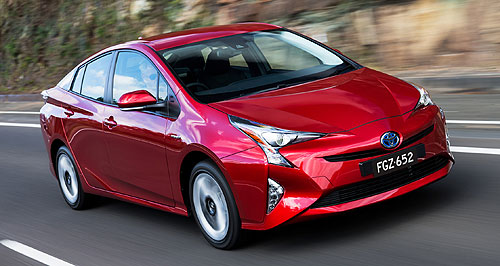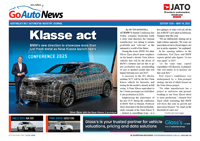New models - Toyota - PriusDriven: Reset for Toyota’s Prius hybrid kingDisconnected: Toyota has made small, cautious steps forward with the new Prius but it has forgone plug-in or new-age batteries. The all-important fourth-generation Prius debuts Toyota’s new platform8 Mar 2016 By NEIL DOWLING TOYOTA has launched its all-new fourth-generation Prius in Australia almost 20 years after the first version sparked a new future and set the car-maker on a hybrid course that it remains on today. The new Prius, with a paper-fold body design over the first showing of the TNGA (Toyota New Generation Architecture) platform that will go on to underpin a string of forthcoming models, starts at $34,990 plus on-road costs – $5000 cheaper than the 2003 version, but $2500 more than the model it replaces. Flagship i-Tech variants are priced from $42,990, which is a $1000 drop over the superseded model. Toyota Australia executive director of sales and marketing Tony Cramb calls the latest Prius a “new perspective” that is “more fun to see, touch and drive”. Ostensibly, the car that spearheaded commercial hybrid sales around the world is a winner. More than 3.6 million have been made since production started in 1997. In recent years in Australia, however, the Prius has struggled in a market where hybrid cars are typically overlooked in favour of economical conventional petrol-engine models or, increasingly, diesel-powered cars. As GoAuto has reported, the 12,138 hybrids sold in last year’s record-breaking 1.155-million-unit market represented a mere 1.05 per cent, and to some extent the Prius has taken a hit from Toyota’s own Camry Hybrid and the Prius C and Prius V derivatives. Prius sales were down 5.7 per cent last year to 459 units – a far cry from the 3413 it sold back in 2008. But the market leader is not daunted, announcing recently that a Corolla Hybrid is on its way, while it sees the Prius as being its pointer to a future vehicle range that will slash emissions and, with it, fuel consumption. In keeping with this goal, the 2016 Prius is more efficient than its predecessor. Fuel consumption is now 3.4 litres per 100 kilometres on the official combined cycle, down 12.8 per cent from 3.9L/100km, marking the biggest fall in consumption in Prius history. The petrol engine remains a 1.8-litre Atkinson-cycle unit driving two electric motors through a continuously variable transmission (CVT) to the front wheels. Combined output is 90kW with the motors offering up to 163Nm of torque. Updates include an electrically operated water pump, low-friction engine and motor components, a new transaxle with more compact and lighter motors, and a smaller engine management unit. All components have been lightened, shrunken, made more efficient and tuned for performance, according to Toyota. The TNGA platform is equivalent to Volkswagen’s MQB common platform and over the ensuing years will be stretched and widened to suit a variety of passenger cars. The next vehicle with TNGA will be the C-HR SUV, due in Australia in the first quarter of 2017, with Toyota promising 50 per cent of its cars will be produced with that platform within five years. The C-HR is also a chance to turn up here with a hybrid engine at some point. In its debut Prius role, the new platform places the driver lower (by 55mm) and picks up a double wishbone rear suspension to replace the torsion bar unit. Toyota said the move was to improve roadholding and ride comfort but the move, together with a battery relocation, has also boosted luggage space up to 502 litres in the i-Tech, which does not have a spare wheel. The base variant offers 457 litres. The body is new, picking up some of the divisive origami lines of Toyota’s globe-trotting Mirai fuel-cell car, with improved features over the previous model including LED headlights. Notable are the vertical foils at the front designed to deflect air from the wheels, and the rear window-splitting spoiler and upright LED tail-lights. Toyota said it crashed 400 cars to get the bodyshell up to a maximum five-star crash-test rating – although it is yet to be tested by ANCAP – on the way getting a 60 per cent increase in torsional rigidity partly because of the platform and also because of the high-tensile steel and new laser welding that delivers 31 per cent more spot welds. As well as the lower driver’s seat, the A-pillars are narrower and the bonnet is lower, all designed to improve visibility while lowering the centre of gravity to enhance the “sporty” roadholding. Unlike the United States market, Toyota Australia has not opted for lithium-ion batteries that appear on the entry-level Eco variant. There is also no plug-in model and it is unlikely one will appear soon. “We can’t see demand for a plug-in version,” said Toyota Australia product planner Michael Elias. He said the nickel-metal hydride (NiMH) batteries in the new model were smaller, lighter and more powerful than in the previous model and had charge rates 28 per cent quicker than before. “They are also less expensive than the lithium-ion batteries so, because there was not a lot of difference in packaging and weight, we remain with the NiMH batteries,” he said. The batteries are set under the rear seat, forward of their position in the third-generation model, so luggage space is improved. But the more expensive i-Tech variant has insufficient space for a spare tyre. It relies on an aerosol repair kit while the base Prius gets a space-saver. Inside, the cabin has more horizontal surfaces but retains the centre position of the instruments. The PlayStation-style electronic gearshifter has been relocated so it is easier to reach, while the seats are more padded and cabin room is improved, especially the fold-down rear seat function. Both variants feature high levels of safety equipment as standard, including autonomous collision mitigation, active cruise control with auto braking, lane-departure warning with a subtle steering wheel intervention and an automatic high-beam function. This is on top of a reversing camera, seven airbags, emergency brake signal, auto-levelling LED headlights and LED daytime running lights. Other standard comfort and connectivity features in the base variant includes a colour head-up display, a 7.0-inch touchscreen wireless smartphone charger, 10-speaker JBL audio system, twin TFT display panels and 15-inch alloy wheels. The i-Tech adds 17-inch alloys, leather-accented upholstery, sat-nav, blind-spot warning and rear cross-traffic alert, heated front seats, eight-way power adjustment for the driver’s seat and a digital radio. 2016 Toyota Prius pricing*
 Quick testsRead more8th of March 2016  Toyota sets a clean futurePrius is Toyota’s stepping stone to a zero-emissions futurePrius pricing
Motor industry news |
|
||||||




































Facebook Twitter Instagram